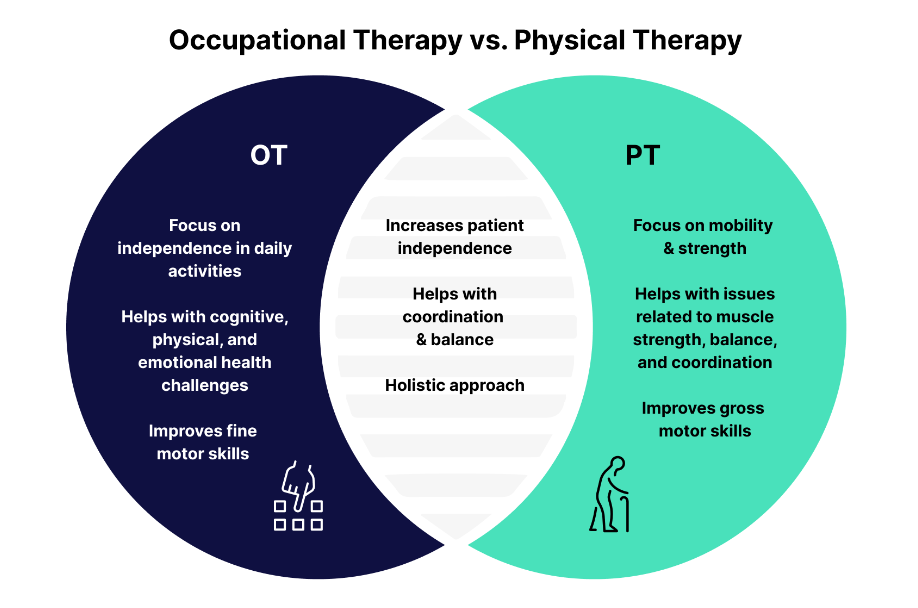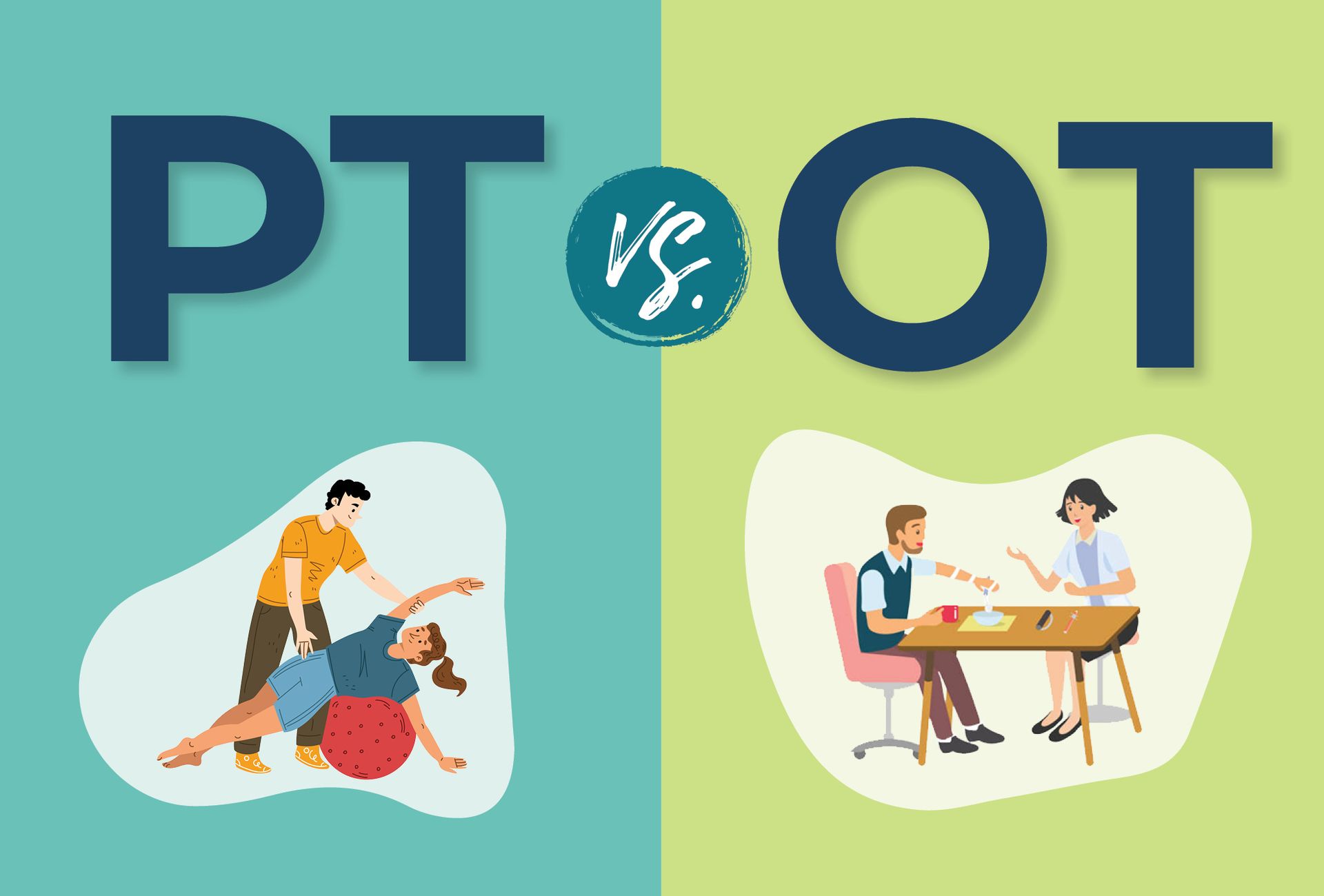Physical Therapy versus Occupational Therapy represents two separate yet interconnected domains within the healthcare sector. Despite sharing the common goal of enhancing individuals’ quality of life and functional capacities, each profession boasts distinct emphases and approaches.
This article delves into the fundamental disparities between Physical and Occupational Therapists, elucidating their respective responsibilities, educational pathways, and target demographics.
What sets apart an occupational therapist from a physical therapist?
Occupational therapists (OTs) and physical therapists (PTs) both operate within the realm of rehabilitation, yet distinct variations exist in their scope and methodologies:

What distinguishes an Occupational therapist from a Physical therapist?
Physical Therapist (PT)
Physical therapists specialize in diagnosing, treating, and preventing movement disorders. To obtain a license as a PT, individuals typically complete a bachelor’s degree in a related field, followed by a Doctor of Physical Therapy (DPT) program. These programs involve rigorous coursework and extensive clinical training to prepare therapists for addressing various physical conditions.
Occupational Therapist (OT)
In contrast, occupational therapists focus on assisting individuals in engaging in meaningful activities and occupations. To become an occupational therapist, individuals usually require a bachelor’s degree, followed by a Master’s in Occupational Therapy (MOT) or a Doctorate in Occupational Therapy (OTD). Like physical therapy programs, occupational therapy programs encompass academic study and clinical practice.
Duties and Emphases of Physical Therapists Compared to Occupational Therapists
Physical Therapist (PT)
Physical therapists primarily concentrate on enhancing a patient’s mobility, strength, and overall physical function. They develop and execute exercise regimens, administer manual therapy, and employ other techniques to address musculoskeletal, neurological, and cardiopulmonary conditions. Physical therapists often collaborate with individuals recovering from injuries, surgeries, or managing chronic conditions.
Occupational Therapist (OT)
Occupational therapists focus on improving an individual’s capacity to engage in everyday activities. Their interventions target fine motor skills, cognitive function, sensory processing, and psychosocial well-being. OTs work with individuals of all ages, aiding them in restoring independence in activities such as self-care, work, and leisure pursuits.
Patient population
Physical Therapist (PT)
Physical therapists typically collaborate with individuals who have orthopedic injuries, neurological conditions (such as stroke or spinal cord injuries), sports-related injuries, and respiratory issues. Additionally, they may provide assistance to individuals recovering from surgeries, fractures, or joint replacements.
Occupational Therapist (OT)
Occupational therapists work with a wide spectrum of populations, including children experiencing developmental delays, individuals grappling with mental health conditions, individuals recuperating from surgeries or accidents, and seniors confronting age-related challenges. They may partner with patients to modify their living environments to enhance functionality.
Collaboration and integration
Although Physical therapists and Occupational therapists have distinct roles, it’s common for them to collaborate. In numerous healthcare environments, PTs and OTs join forces to deliver comprehensive patient care. For instance, a stroke survivor might undergo physical therapy to enhance mobility and occupational therapy to reacquire essential daily living skills.
Occupational therapist vs physical therapist salary
Both physical therapists (PTs) and occupational therapists (OTs) play crucial roles as healthcare team members, aiding individuals of all ages in injury recovery, chronic condition management, and overall well-being. While their endeavors share similarities, notable distinctions exist, including variances in their salaries as occupational therapists versus physical therapists.
Average Occupational therapist vs Physical therapist salary
Physical Therapist (PT)
As reported by the Bureau of Labor Statistics, the median annual salary for physical therapists in the United States reached $97,960 in May 2023. Those in the bottom 10% of earners made less than $67,910, while the top 10% earned more than $128,830.
Occupational Therapist (OT)
For occupational therapists in the United States, the median annual salary was $92,800 in May 2023. Individuals in the bottom 10% of earners made less than $63,320, while those in the top 10% earned more than $123,870.
Factors affecting occupational therapist vs physical therapist salary
Several factors can influence the salary of both PTs and OTs, including:
- Experience: Therapists with greater experience typically command higher salaries compared to those with less experience.
- Education: Some employers may offer higher salaries to therapists with advanced degrees such as a master’s degree.
- Location: Therapists working in urban areas, where the cost of living is higher, generally earn more than those in rural areas.
- Setting: Therapists employed in hospitals or acute care facilities may receive higher salaries than those working in home health or community settings.
- Specialization: Therapists specializing in specific areas such as pediatrics or geriatrics may earn more than those working with a general population.
Job outlook
The employment prospects for both PTs and OTs are promising. According to the Bureau of Labor Statistics, the demand for PTs is expected to increase by 23% from 2022 to 2032, significantly outpacing the average growth rate for all occupations. Similarly, the job outlook for OTs is robust, with employment anticipated to grow by 17% during the same period.

Settings of physical therapist vs occupational therapist
Although both professions are commonly present in hospitals and outpatient clinics, their work environments can differ. Physical therapists are frequently employed in rehabilitation centers, sports medicine facilities, and pain management clinics. In addition to these settings, occupational therapists may also practice in schools, home healthcare, community centers, and mental health facilities.
Overlap and collaboration of physical therapist vs occupational therapist
It’s worth mentioning that the distinctions between PT and OT can occasionally become less clear. For example, an individual recovering from a stroke might find value in both therapies – engaging with a PT to rebuild strength and mobility, while also collaborating with an OT to reacquire dressing or cooking abilities. Consequently, PTs and OTs frequently team up to deliver comprehensive care, aiming to achieve the most favorable outcomes for their patients.
Conclusion
While both physical therapists and occupational therapists play pivotal roles in healthcare, their distinct focuses provide patients with unique advantages. Physical therapists excel in restoring movement and function, aiding individuals in overcoming physical limitations and reclaiming independence. On the other hand, occupational therapists empower individuals to engage in meaningful activities, assisting them in adapting to their environment and navigating daily life challenges. Ultimately, the choice between PT and OT hinges on individual needs, goals, and also considerations like occupational therapist vs physical therapist salary. However, it’s important to recognize that these professions frequently collaborate, offering comprehensive care that enables individuals to reach their full potential and lead fulfilling lives.




